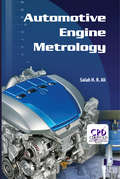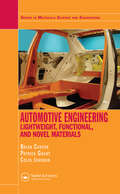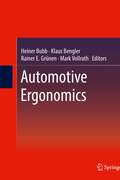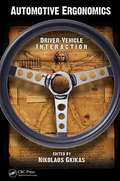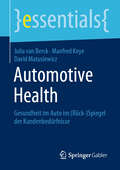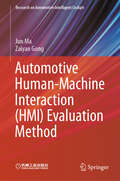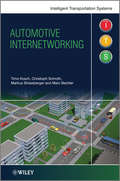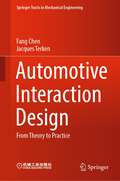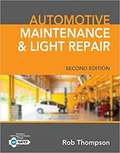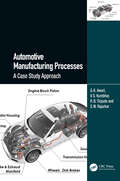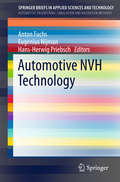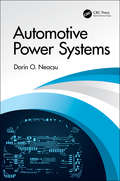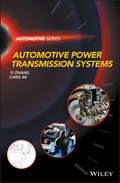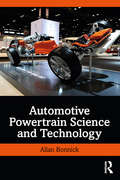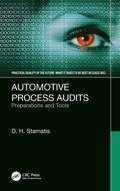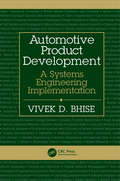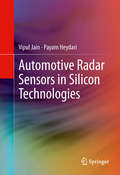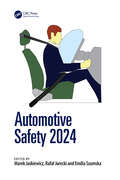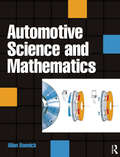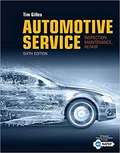- Table View
- List View
Automotive Engine Metrology
by Salah H. AliIn recent decades, metrology—an accurate and precise technology of high quality for automotive engines—has garnered a great deal of scientific interest due to its unique advanced soft engineering techniques in design and diagnostics. Used in a variety of scientific applications, these techniques are now widely regarded as safer, more efficient, and more effective than traditional ones. This book compiles and details the cutting-edge research in science and engineering from the Egyptian Metrology Institute (National Institute for Standards) that is revolutionizing advanced dimensional techniques through the development of coordinate and surface metrology.
Automotive Engineering: Lightweight, Functional, and Novel Materials (Series in Materials Science and Engineering)
by Patrick Grant Colin Johnston Brian CantorThe current automotive industry faces numerous challenges, including increased global competition, more stringent environmental and safety requirements, the need for higher performance vehicles, and reducing costs. The materials used in automotive engineering play key roles in overcoming these issues. Automotive Engineering: Lightweight, Functional
Automotive Ergonomics
by Heiner Bubb Klaus Bengler Rainer E. Grünen Mark VollrathErgonomics teaches how to design technology in such a way that it is optimally adapted to the needs, wishes and characteristics of the user. In this context, the concept of the human-machine system has become established. In a systematic way and with a detailed view of the complicated technical and perceptual psychological and methodological connections, this book explains the basics of automotive ergonomics with numerous examples. The application is shown in examples such as package, design of displays and control elements, of environmental ergonomics such as lighting, sound, vibrations, climate and smell. The design of driver assistance systems from an ergonomic perspective is also a central topic. The book is rounded off by methods of ergonomic vehicle development, the use of mock-ups, driving simulators and tests in real vehicles and prototypes. For the first time, those responsible in the automotive industry and in the field of relevant research are provided with a specialized systematic work that provides the ergonomic findings in the design of today's automobiles. This provides planners and designers of today's automobiles with concrete information for ergonomic product development, enabling them to keep an eye on decisive requirements and subsequent customer acceptance.This book is a translation of the original German 1st edition Automobilergonomie by Heiner Bubb, Klaus Bengler, Rainer E. Grünen & Mark Vollrath, published by Springer Fachmedien Wiesbaden GmbH, part of Springer Nature in 2015. The translation was done with the help of artificial intelligence (machine translation by the service DeepL.com). A subsequent human revision was done primarily in terms of content, so that the book will read stylistically differently from a conventional translation. Springer Nature works continuously to further the development of tools for the production of books and on the related technologies to support the authors.
Automotive Ergonomics: Driver-Vehicle Interaction
by Nikolaos GkikasIn the last 20 years, technological developments have set new standards in driver-vehicle interaction. These developments effect the entire lifecycle, from the moment a customer enters a dealership to examine a prospective vehicle, to the driving experience during the vehicle lifecycle, and the interaction with other road users and facilities in pl
Automotive Ethernet
by Kirsten Matheus Thomas KönigsederDo you need to get up to date with the world's most popular networking technology? With this resource you will discover everything you need to know about Ethernet and its implementation in the automotive industry. Enhance your technical understanding and better inform your decision-making process so that you can experience the benefits of Ethernet implementation. From new market opportunities, to lower costs, and less complex processes; this is the first book to provide a comprehensive overview of automotive Ethernet. Covering electromagnetic requirements and physical layer technologies, Quality of Service, the use of VLANs, IP, and Service Discovery, as well as network architecture and testing, this unique and comprehensive resource is a must have, whether you are a professional in the automotive industry, or an academic who needs a detailed overview of this revolutionary technology and its historical background.
Automotive Ethernet
by Kirsten Matheus Thomas KönigsederDo you need to get up to date with the world's most popular networking technology? With this resource you will discover everything you need to know about Ethernet and its implementation in the automotive industry. Enhance your technical understanding and better inform your decision-making process so that you can experience the benefits of Ethernet implementation. From new market opportunities, to lower costs, and less complex processes; this is the first book to provide a comprehensive overview of automotive Ethernet. Covering electromagnetic requirements and physical layer technologies, Quality of Service, the use of VLANs, IP, and Service Discovery, as well as network architecture and testing, this unique and comprehensive resource is a must have, whether you are a professional in the automotive industry, or an academic who needs a detailed overview of this revolutionary technology and its historical background.
Automotive Health: Gesundheit im Auto im (Rück-)Spiegel der Kundenbedürfnisse (essentials)
by David Matusiewicz Manfred Knye Julia van BerckAutomotive Health ermöglicht den Menschen, ihre Gesundheit während der Fahrt zu erfassen und damit präventive oder kurative Maßnahmen einzuleiten. Das Konzept unterstützt dabei den selbstbestimmten Umgang mit der eigenen Gesundheit. In diesem essential werden die Ergebnisse einer empirischen Studie vorgestellt, die die Kundenbedürfnisse nach Automotive Health untersucht und herausgestellt hat, welchen Einfluss z. B. der Gesundheitszustand oder die digitale Affinität auf die Nutzenbereitschaft von digitalen Gesundheitsangeboten im Auto haben.Die Autoren:Julia van Berck M.Sc. ist Projektmanagerin für Kooperationen im Gesundheits- und Sozialwesen an der FOM Hochschule für Oekonomie & Management. Dr. med. Manfred Knye ist Leiter des Projekts Einführung Exoskelette, Digitalisierung und Automotive Health der Volkswagen AG und beschäftigt sich mit dem Thema Gesundheit 4.0. Prof. Dr. David Matusiewicz ist Direktor des Instituts für Gesundheit & Soziales (ifgs) und Dekan des Hochschulbereiches Gesundheit & Soziales an der FOM Hochschule für Oekonomie & Management.
Automotive Human-Machine Interaction (Research on Automotive Intelligent Cockpit)
by Jun Ma Zaiyan GongThis book focuses on the evaluation methodology for automotive human-machine interaction (HMI), which aim to reduce driving distractions, lower operational loads, optimize user experience design, and enhance user value.The book is divided into three parts. The first part, consisting of Chapters 1–3, introduces the evolution of automotive HMI and proposes a three-dimensional orthogonal evaluation system for automotive HMI that is comprehensive, systematic, and quantifiable. This evaluation system incorporates all evaluation items into a spatial matrix consisting of three dimensions: interaction tasks, interaction modalities, and evaluation indexes. The second part provides a comprehensive presentation and in-depth discussion of the evaluation indexes. The three rational evaluation indexes are utility, safety, and efficiency, which can be tested by the real-car driving simulator. The four emotional evaluation indexes are cognition, intelligence, value, and aesthetics. In orderto standardize the latter two subjective indexes, this book summarizes common differences in value between Chinese and European users and organizes typical aesthetic orientations in automotive UI based on art history research. The third part introduces the application of this HMI evaluation system in the automotive R&D process, including how to integrate the evaluation into a real product development process to achieve efficient product iteration.This book is suitable for intelligent cockpit and HMI designers, engineers, and researchers. It is also used as a reference for product managers and students in the field of intelligent connected vehicles.
Automotive Innovation: The Science and Engineering behind Cutting-Edge Automotive Technology
by Patrick HossayAutomotive Innovation: The Science and Engineering behind Cutting-Edge Automotive Technology provides a survey of innovative automotive technologies in the auto industry. Automobiles are rapidly changing, and this text explores these trends. IC engines, transmissions, and chassis are being improved, and there are advances in digital control, manufacturing, and materials. New vehicles demonstrate improved performance, safety and efficiency factors; electric vehicles represent a green energy alternative, while sensor technologies and computer processors redefine the nature of driving. The text explores these changes, the engineering and science behind them, and directions for the future.
Automotive Inter-networking
by Marc Bechler Timo Kosch Markus Strassberger Christoph SchrothA complete introduction tocar-to-X communications networkingAutomotive Inter-networking will introduce a range of new network and system technologies for vehicle safety, entertainment and comfort systems currently being researched and developed. C2X networking is not only a matter of technology, but is also very closely related to policy-making about deployment. This book will provide the background on technical developments but will also discuss the potential benefits, costs and risks. Also discussed will be concepts related to application of vehicle-to-vehicle and vehicle-to-infrastructure communication technologies for various purposes such as automobile safety enhancement, vehicle user applications for comfort and convenience and efficiency along with other potential commercial applications.Application domains will build the starting point for an analysis of the requirements on suitable mobile network technology and the book will look at how well existing and new systems match these requirements. New automotive-specific technologies are presented in detail, explaining millimeter wave short range systems and special automotive network protocols. Specially designed system services and security mechanisms are introduced and system architecture, radio spectrum use, medium access control, network protocols and security concepts and considered. Finally, the book will present the current world-wide standardization activities, deployment strategies and an outlook about the evolvement of inter-vehicle communications in the next decades.Presents a comprehensive top-down approach to the newly evolving car-to-X communications networkingProvides a broad overview of all relevant C2X communication topicsWritten by well known experts in the fieldPredicts the outlook of the evolvement of inter-vehicle communications in the next decadesIncludes illustrations and high-level technical sketches of application domains and photographs, 3D renderings and professional graphical sketches of current prototypes
Automotive Interaction Design: From Theory to Practice (Springer Tracts in Mechanical Engineering)
by Fang Chen Jacques TerkenThis book focuses on the design of the in-car human–machine interface (HMI) and the design-relevant psychology. It combines a design perspective with an applied theoretical perspective. The design perspective informs the reader about how to set up a design process that puts users at the centre of the design process. The theoretical perspective provides the reader with an understanding of concepts from perception and cognitive psychology, supporting the decision-making in the design process. This is an ideal book for automotive engineers and practitioners in the automotive industry who face the challenge of designing information and entertainment systems, advanced driver assistance systems (ADAS) and automated driving systems (ADS), and the associated HMIs.
Automotive Manufacturing Processes: A Case Study Approach
by G.K. Awari V.S. Kumbhar R.B. Tirpude S.W. RajurkarAutomotive Manufacturing Processes discusses basic principles and operational procedures of automotive manufacturing processes, issues in the automotive industry like material selection, and troubleshooting. Every chapter includes specific learning objectives, multiple-choice questions to test conceptual understanding of the subject and put theory into practice, review questions, solved problems, and unsolved exercises. It covers important topics including material decision-making processes, surface hardening processes, heat treatment processes, effects of friction and velocity distribution, the metallurgical spectrum of forging, and surface finishing processes. Features: Discusses automotive manufacturing processes in a comprehensive manner with the help of applications. Provides case studies addressing issues in the automotive industry and manufacturing operations in the production of vehicles. Discussion on material properties while laying emphasis on the materials and processing parameters. Covers applications and case studies of the automotive industry. The text will be useful for senior undergraduates, graduate students and academic researchers in areas including automobile engineering, industrial and manufacturing engineering and mechanical engineering.
Automotive NVH Technology (SpringerBriefs in Applied Sciences and Technology)
by Anton Fuchs Eugenius Nijman Hans-Herwig PriebschThis book presents seven chapters examining selectednoise, vibration and harshness (NVH) topics that are highly relevant for automotivevehicle development. These include applications following the major trends towardincreased passenger comfort, vehicle electrification and lightweight design. The authors of the seven chapters, all of which are experts from the automotiveindustry and academia, present the foremost challenges and potential solutionsin this demanding field. Among others, applications for sound optimization indownsized engines, noise optimization in electric powertrains, weight reductionoptions for exhaust systems, porous materials description, and thevibro-acoustic analysis of geared systems are discussed.
Automotive Painting Technology: A Monozukuri-Hitozukuri Perspective
by Kozo Saito Abraham Salazar Kimio TodaThis book offers unique and valuable contributions to the field. It offers breadth and inclusiveness. Most existing works on automotive painting cover only a single aspect of this complex topic, such as the chemistry of paint or paint booth technology. Monozukuri and Hitozukuri are Japanese terms that can be translated as "making things" and "developing people" but their implications in Japanese are richer and more complex than this minimal translation would indicate. The Monozukuri-Hitozukuri perspective is drawn from essential principles on which the Toyota approach to problem-solving and continuous improvement is based. From this perspective, neither painting technology R&D nor painting technology use in manufacturing can be done successfully without integrating technological and human concerns involved with making and learning in the broadest sense, as the hyphen is meant to indicate. The editors provide case studies and examples -- drawn from Mr. Toda's 33 years of experience with automotive painting at Toyota and from Dr. Saito's 18 years experience with IR4TD, the research-for-development group he leads at the University of Kentucky -- that give details on how these two principles can be integrated for successful problem-solving and innovation in industry, in university R&D, and in the collaboration between the two. The book will bring readers up to date on progress in the field over the last decade to provide a basis for and to indicate fruitful directions in future R&D and technology innovation for automotive painting.
Automotive Power Systems
by Dorin O. NeacșuVehicles are intrinsically linked to our lives. This book covers all technical details of the vehicle electrification process, with focus on power electronics. The main challenge in vehicle electrification consists of replacing the engine-based mechanical, pneumatic, or hydraulic ancillary energy sources with electrical energy processed through an electromagnetic device. The book illustrates this evolutionary process with numerous series-production examples for either of body or chassis systems, from old milestones to futuristic luxury vehicles. Electrification of ancillaries and electric propulsion eventually meet into an all-electric vehicle and both processes rely heavily on power electronics. Power electronics deals with electronic processing of electrical energy. This makes it a support technology for the automotive industry. All the automotive visions for the next decade (2020-2030) are built on top of power electronics and the automotive power electronics industry is expected at 15% compound annual growth rate, the highest among all automotive technologies. Hence, automotive power electronics industry is very appealing for recent and future graduates. The book structure follows the architecture of the electrical power system for a conventional engine-based vehicle, with a last chapter dedicated to an introduction onto electric propulsion. The first part of the book describes automotive technologies for generation and distribution of electrical power, as well as its usage within body systems, chassis systems, or lighting. The second part explores deeper into the specifics of each component of the vehicle electric power system. Since cars have been on the streets for over 100 years, each chapter starts with a list of historical achievements. Recognizing the engineering effort span over more than a century ennobles the R&D efforts of the new millennium. Focus on history of electricity in vehicle applications is another attractive treat of the book. The book fills a gap between books targeting practical education and works sharing advanced academic vision, offering students and academics a quick tour of the basic tools and long-standing infrastructure, and offering practicing engineers an introduction on newly introduced power electronics-based technologies. It is therefore recommended as a must-have book for students and early graduates in automotive power electronics activities.
Automotive Power Transmission Systems (Automotive Series)
by Chris Mi Yi ZhangProvides technical details and developments for all automotive power transmission systems The transmission system of an automotive vehicle is the key to the dynamic performance, drivability and comfort, and fuel economy. Modern advanced transmission systems are the combination of mechanical, electrical and electronic subsystems. The development of transmission products requires the synergy of multi-disciplinary expertise in mechanical engineering, electrical engineering, and electronic and software engineering. Automotive Power Transmission Systems comprehensively covers various types of power transmission systems of ground vehicles, including conventional automobiles driven by internal combustion engines, and electric and hybrid vehicles. The book covers the technical aspects of design, analysis and control for manual transmissions, automatic transmission, CVTs, dual clutch transmissions, electric drives, and hybrid power systems. It not only presents the technical details of key transmission components, but also covers the system integration for dynamic analysis and control. Key features: Covers conventional automobiles as well as electric and hybrid vehicles. Covers aspects of design, analysis and control. Includes the most recent developments in the field of automotive power transmission systems. The book is essential reading for researchers and practitioners in automotive, mechanical and electrical engineering.
Automotive Powertrain Science and Technology
by Allan BonnickA motor vehicle’s powertrain consists of the components which generate power and enable it to move – its engine, exhaust system, transmission, drive shaft, suspension and wheels. Any automotive engineering student going beyond basic mechanics will need a sound knowledge of the mathematics and scientific principles, particularly calculus and algebra, which underpin powertrain technology. This textbook supports a series of courses, for instance BTEC unit 28 “Further Mathematics for Engineering Technicians”, which is a requisite for a foundation degree in automotive engineering, and BTEC higher unit 25 “Engine and Vehicle Design and Performance”, without giving full coverage of automotive technology. It is a more focused companion to the author’s Automotive Science and Mathematics 978-0-7506-8522-1, also published by Routledge.
Automotive Process Audits: Preparations and Tools (Practical Quality of the Future)
by D. H. StamatisWith a detailed discussion on the preparation and tools needed for an automotive process audit, this book addresses the fundamental issues and concerns by focusing on two objectives: explaining the methods and tools used in the process for the organization, and provide a reference or manual for dealing with documenting quality issues. This book addresses the fundamental issues and concerns for a successful automotive process audit and details specifically how to prepare for it. It presents a complete assessment of what an organization must do to earn certification in ISO standards, industry standards, and customer-specific requirements. It also focuses on the efficiency of resources within an organization so that an audit can be successful and describes the methodologies to optimize the process by knowing what to do, what to say, and how to prove it. A road map is offered for the "process audit" and the "layered audit," and defines a clear distinction between the preparation details for each. This book is intended for those that conduct audits, those who are interested in auditing, and those who are being audited. It specifically addresses how to prepare for an automotive process audit for readers who are involved in quality, manufacturing, and operations management, and those who work with suppliers.
Automotive Product Development: A Systems Engineering Implementation
by Vivek D. BhiseThis book is about how to develop future automotive products by applying the latest methodologies based on a systems engineering approach and by taking into account many issues facing the auto industry such as meeting government safety, emissions and fuel economy regulations, incorporating advances in new technology applications in structural materials, power trains, vehicle lighting systems, displays and telematics, and satisfying the very demanding customer. It is financially disastrous for any automotive company to create a vehicle that very few people want. To design an automotive product that will be successful in the marketplace requires carefully orchestrated teamwork of experts from many disciplines, substantial amount of resources, and application of proven techniques at the right time during the product development process. Automotive Product Development: A Systems Engineering Implementation is intended for company management personnel and graduate students in engineering, business management and other disciplines associated with the development of automotive and other complex products.
Automotive Radar Sensors in Silicon Technologies: Circuits And Systems
by Payam Heydari Vipul JainOne of the leading causes of automobile accidents is the slow reaction of the driver while responding to a hazardous situation. State-of-the-art wireless electronics can automate several driving functions, leading to significant reduction in human error and improvement in vehicle safety. With continuous transistor scaling, silicon fabrication technology now has the potential to substantially reduce the cost of automotive radar sensors. This book bridges an existing gap between information available on dependable system/architecture design and circuit design. It provides the background of the field and detailed description of recent research and development of silicon-based radar sensors. System-level requirements and circuit topologies for radar transceivers are described in detail. Holistic approaches towards designing radar sensors are validated with several examples of highly-integrated radar ICs in silicon technologies. Circuit techniques to design millimeter-wave circuits in silicon technologies are discussed in depth.
Automotive Safety 2024: Proceedings of the 14th International Science and Technical Conference Automotive Safety (Sandomierz, Poland, 24-26 April 2024)
by Marek JaśkiewiczAutomotive Safety 2024 presents a comprehensive selection of 36 papers from the 14th International Science and Technical Conference: Automotive Safety 2024. The intricate nature of safety issues and continuous advancements in automotive technology drive a steady stream of novel and captivating scientific and technical developments at each edition of the Conference. The contributions delve into a wide range of automotive safety topics, from broad-based studies to specific applications, encompassing object recognition, accident reconstruction, autonomous vehicles, driver behaviour, micromobility, and the perception of intelligent technologies. This book constitutes significant and insightful additions to the knowledge in automotive safety, serving as a potential impetus for further scholarly endeavours.
Automotive Science and Mathematics
by Allan BonnickAutomotive technicians and students need a firm grasp of science and technology in order to fully appreciate and understand how mechanisms and systems of modern vehicles work. Automotive Science and Mathematics presents the necessary principles and applications with all the examples and exercises relating directly to motor vehicle technology and repair, making it easy for automotive students and apprentices to relate the theory back to their working practice.The coverage of this book is based on the syllabus requirements of the BTEC First in Vehicle Technology, BTEC National in Vehicle Repair and Technology, and the IMI Certificate and Diploma in Vehicle Maintenance and Repair, but will help all automotive students and apprentices at levels 2 and 3 and up to and including HNC/HND, foundation and first degree with their studies and in achieving the Key Skill 'Application of Number' at levels 2 and 3. The book is designed to cater for both light and heavy vehicle courses.Full worked solutions of most exercises are available as a free download for lecturers only from http://textbooks.elsevier.com.Allan Bonnick is a motor vehicle education and training consultant and was formerly Head of Motor Vehicle Engineering, Eastbourne College. He is the author of several established automotive engineering textbooks.
Automotive Security Analyzer for Exploitability Risks: An Automated and Attack Graph-Based Evaluation of On-Board Networks
by Martin SalferOur lives depend on automotive cybersecurity, protecting us inside and near vehicles. If vehicles go rogue, they can operate against the driver’s will and potentially drive off a cliff or into a crowd. The “Automotive Security Analyzer for Exploitability Risks” (AutoSAlfER) evaluates the exploitability risks of automotive on-board networks by attack graphs. AutoSAlfER’s Multi-Path Attack Graph algorithm is 40 to 200 times smaller in RAM and 200 to 5 000 times faster than a comparable implementation using Bayesian networks, and the Single-Path Attack Graph algorithm constructs the most reasonable attack path per asset with a computational, asymptotic complexity of only O(n * log(n)), instead of O(n²). AutoSAlfER runs on a self-written graph database, heuristics, pruning, and homogenized Gaussian distributions and boosts people’s productivity for a more sustainable and secure automotive on-board network. Ultimately, we enjoy more safety and security in and around autonomous, connected, electrified, and shared vehicles.
